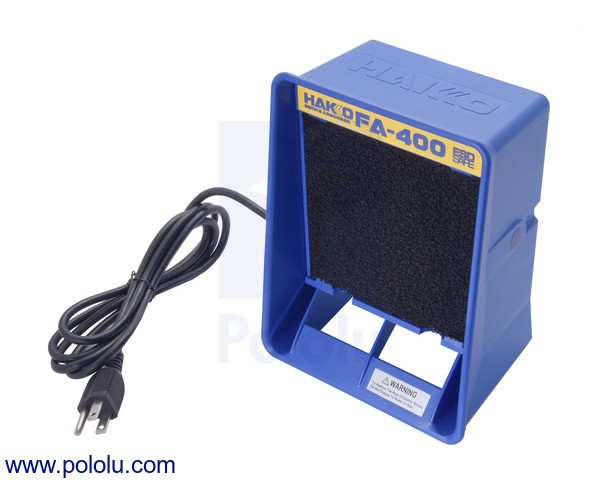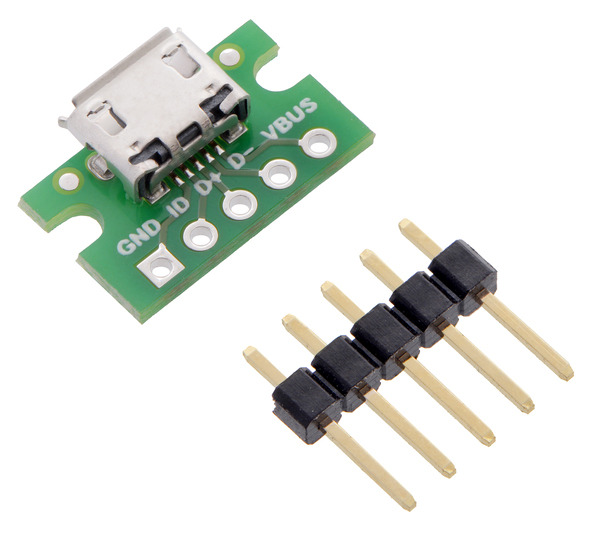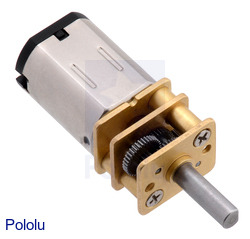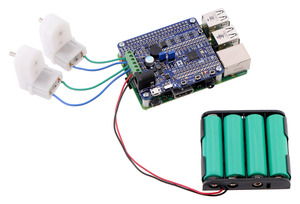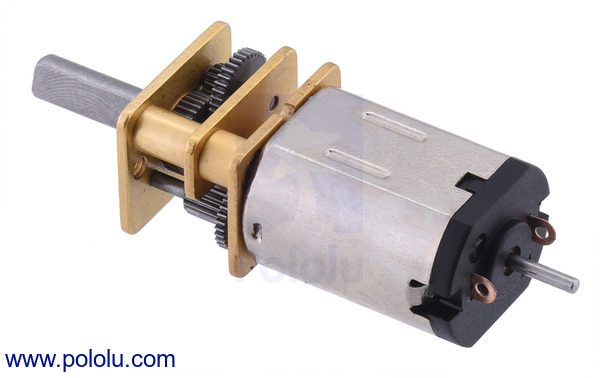Pololu Blog » Posts tagged “new products” »
Posts tagged “new products” (Page 16)
You are currently viewing a selection of posts from the Pololu Blog. You can also view all the posts.
Popular tags: community projects new products raspberry pi arduino more…
New product: T1-3/4 (5mm) RGB LED with Diffused Lens (5-pack)
We are now selling T1-3/4 (5mm) common anode RGB LEDs! These multi-color LEDs contain red, green, and blue (RGB) elements that can be mixed to produce different colors. The three color elements share a common anode and are encased in a diffused white lens that blends the colors and widens the viewing angle. This product is a pack of five (5) RGB LEDs.
 |
These LEDs replace the RGB LEDs with a common cathode that we used to sell. The common-anode setup of the new ones is nice because you can drive the LEDs with a low-voltage microcontroller I/O pin in an open-drain configuration (provided the pins can handle the current and are tolerant of the LED supply voltage). If you need to build your own drive circuit, you just need one low-side transistor per LED.
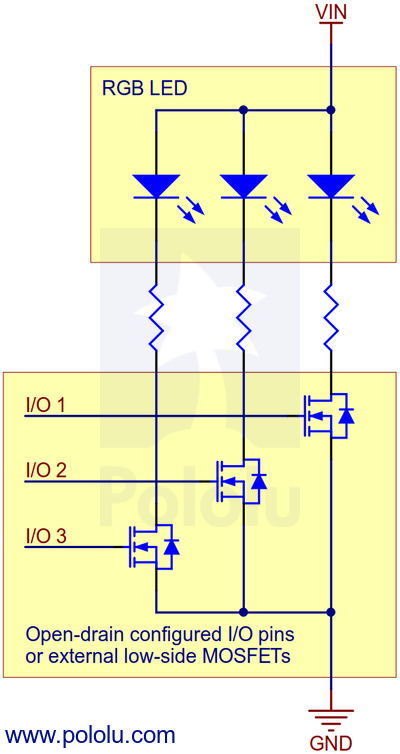 |
Here are some other posts on our blog about LEDs:
New product: Magnetic Encoder Pair Kit for Mini Plastic Gearmotors
We now have a magnetic encoder pair kit available for our mini plastic gearmotors with extended back shafts. Like our encoder kit for micro metal gearmotors, these kits consist of Hall effect sensor boards that mount to the back of the motors and magnetic discs that fit on the motors’ back shafts. The encoders provide a resolution of 12 counts per revolution of the motor shaft (when counting both edges of both channels); in terms of counts per gearbox output shaft revolution, the resolution is multiplied by the corresponding gear ratio.
 |
For more details about the encoder kit, see the product page.
New product: VL53L0X Time-of-Flight Distance Sensor Carrier
We’ve just released our VL53L0X Time-of-Flight Distance Sensor Carrier. With its ability to measure distances up to 2 m depending on configuration, target, and environment, the VL53L0X is a longer-range version of the VL6180X (but without ambient light sensing functionality) that operates using the same principles. This integrated lidar module times how long it takes for pulses of infrared light to reach a target, reflect off it, and arrive back at the sensor. It uses this information to report the range to the target with a resolution of 1 mm and accuracy as good as ±3%, minimizing the effect of the target’s reflectance on the measured distance.
 |
VL53L0X datasheet graph of typical ranging performance (in default mode). |
|---|
As usual, our breakout board adds a 2.8 V regulator and level shifters to help interface with 3.3 V and 5 V systems, as well as a breadboard-compatible pinout and mounting holes. We are also working on an Arduino library for the VL53L0X that we expect to release in the next few days.
For more information about the VL53L0X carrier, see its product page.
New product: Hakko FA-400 Smoke Absorber
We are now offering the Hakko FA-400 Smoke Absorber. The Hakko FA-400 is a benchtop smoke absorber for removing smoke generated by soldering. It has an easily-replaceable activated-carbon filter and a sturdy ESD-safe housing that can be oriented horizontally or vertically.
New version of our USB Micro-B breakout
We’ve updated our USB Micro-B Connector Breakout Board with some minor improvements that should make it a little nicer to work with.
On the original version, the mounting cutouts didn’t work as well as we wanted: they were shallow, and the board was often prone to slipping out of place between two screws. The new version is wider and its cutouts are deeper to allow for more secure mounting, and it is slightly shorter in the other direction (0.4″ × 0.6″ with the connector).
For more information, see the board’s product page.
New 12 V micro metal gearmotors
Our micro metal gearmotors are now available in 12 V versions! These high-power motors have long-life carbon brushes (HPCB) and offer the same performance as the 6 V HPCB motors at their respective nominal voltages; the only difference is that the 12 V motor draws half the current at twice the voltage.
The new 12 V gearmotors are available across our usual range of 11 gear ratios and in single- and dual-shaft versions. Along with our existing selection of micro metal gearmotors, this brings the total number of unique options available to 107:
| Rated Voltage |
Motor Type | Stall Current @ Rated Voltage |
No-Load Speed @ Rated Voltage |
Approximate Stall Torque @ Rated Voltage |
 Single-Shaft (Gearbox Only) |
 Dual-Shaft (Gearbox & Motor) |
|---|---|---|---|---|---|---|
| 12 V | high-power, carbon brushes (HPCB) |
800 mA | 6000 RPM | 2 oz-in | 5:1 HPCB 12V | 5:1 HPCB 12V dual-shaft |
| 3000 RPM | 4 oz-in | 10:1 HPCB 12V | 10:1 HPCB 12V dual-shaft | |||
| 1000 RPM | 9 oz-in | 30:1 HPCB 12V | 30:1 HPCB 12V dual-shaft | |||
| 625 RPM | 15 oz-in | 50:1 HPCB 12V | 50:1 HPCB 12V dual-shaft | |||
| 400 RPM | 22 oz-in | 75:1 HPCB 12V | 75:1 HPCB 12V dual-shaft | |||
| 320 RPM | 30 oz-in | 100:1 HPCB 12V | 100:1 HPCB 12V dual-shaft | |||
| 200 RPM | 40 oz-in | 150:1 HPCB 12V | 150:1 HPCB 12V dual-shaft | |||
| 140 RPM | 50 oz-in | 210:1 HPCB 12V | 210:1 HPCB 12V dual-shaft | |||
| 120 RPM | 60 oz-in | 250:1 HPCB 12V | 250:1 HPCB 12V dual-shaft | |||
| 100 RPM | 70 oz-in | 298:1 HPCB 12V | 298:1 HPCB 12V dual-shaft | |||
| 32 RPM | 125 oz-in | 1000:1 HPCB 12V | 1000:1 HPCB 12V dual-shaft | |||
New product: Raspberry Pi 3 Model B
We are now offering the Raspberry Pi 3 Model B. The Raspberry Pi is a popular credit card-sized computer that can run ARM Linux distributions. As the successor to the Raspberry Pi 2 Model B, the Pi 3 has a more powerful processor and adds wireless connectivity. Here are the specific improvements:
- 1.2 GHz 64-bit quad-core ARMv8 CPU
- 802.11n Wireless LAN
- Bluetooth 4.1
- Bluetooth Low Energy (BLE)
Along with these improvements, the Raspberry Pi 3 maintains compatibility with and the form factor of the previous Pi 2 (and Pi 1 Model B+). With its 0.1″-spaced GPIO header and small size, the Raspberry Pi also works as a programmable controller in a wide variety of robotics and electronics applications. It can also be combined with our A-Star 32U4 Robot Controller LV with Raspberry Pi Bridge to make a great controller for a small robot. We also carry a selection of Raspberry Pi expansion boards.
|
|
This comparison chart can help in selecting the right Raspberry Pi for your project:
 Raspberry Pi Model A+ 512MB |
 Raspberry Pi Model B+ |
 Raspberry Pi 2 Model B |
 Raspberry Pi 3 Model B |
 Raspberry Pi 3 Model B+ |
|
|---|---|---|---|---|---|
| CPU: | BCM2835 | BCM2836 | BCM2837 | BCM2837B0 | |
| CPU cores: | 1 | 4 | |||
| CPU speed: | 700 MHz | 900 MHz | 1.2 GHz | 1.4 GHz | |
| RAM: | 512 MB | 512 MB | 1 GB | ||
| Ethernet: | No | Yes | |||
| WiFi: | No | 2.4 GHz 802.11n | 2.4 GHz 5 GHz 802.11b/g/n/ac | ||
| Bluetooth: | No | 4.1 | 4.2 | ||
| Bluetooth Low Energy: | No | Yes | |||
| HDMI: | Yes | ||||
| Analog video: | Yes1 | ||||
| SD socket: | microSD | ||||
| Onboard regulators: | switching | ||||
| Expansion header pins: | 40 | ||||
| USB ports: | 1 | 4 | |||
| Mounting holes: | 4 | ||||
| Dimensions2: | 2.5″ × 2.2″ × 0.47″ | 3.35″ × 2.2″ × 0.8″ | |||
| Weight3: | 23 g | 42 g | 50 g | ||
1 Audio and analog video provided by a single four-pole 3.5 mm jack. This 3.5 mm jack also has its own dedicated low-noise power supply for improved audio.
2 Length and width measurements are for the PCB only; several of the connectors extend past the edge of the board.
3 Weight does not include microSD cards.
Sixteen new micro metal gearmotor versions!
We just added 16 new micro metal gearmotors to our already huge selection, including three totally new MP (medium power) gear ratios: 5:1 MP, 210:1 MP, and 250:1 MP. With these new additions, we now have dual-shaft versions available in any combination of our 11 gear ratios and four motor types, giving you 44 different options that work with encoders like our magnetic encoder pair kit.
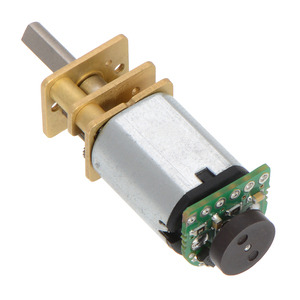 |
Magnetic Encoder Kit for Micro Metal Gearmotors assembled on a micro metal gearmotor with extended motor shaft. |
|---|
In all, this increases our total selection of micro metal gearmotors to 85 unique options:
New version of the Wixel Shield for Arduino
We’ve updated our Wixel Shield for Arduino with a few minor improvements. The Wixel Shield provides an easy way to connect a Wixel wireless module to your Arduino or A-Star 32U4 Prime, enabling wireless communication and even wireless programming (on some Arduinos). However, the original version of the shield was released many years ago, so it was not designed with the modern pinout of the Arduino Uno R3 in mind.
The Wixel Shield v1.1 adds pass-throughs for the four new pins—SCL, SDA, IOREF, and an unused pin—introduced by the R3 and present on all newer Arduinos, making it easier to stack other shields with it (especially ones that make use of the new I²C pin location). It also features improved level shifter circuits that make use of the IOREF voltage provided by the Arduino, allowing the shield to work automatically with both 5 V and 3.3 V Arduino boards.
The Wixel Shield for Arduino v1.1 is available by itself and as part of a combination deal that includes a pair of Wixels and a USB cable. See the user’s guide for the shield for additional information.
New product: MP3 Trigger V24
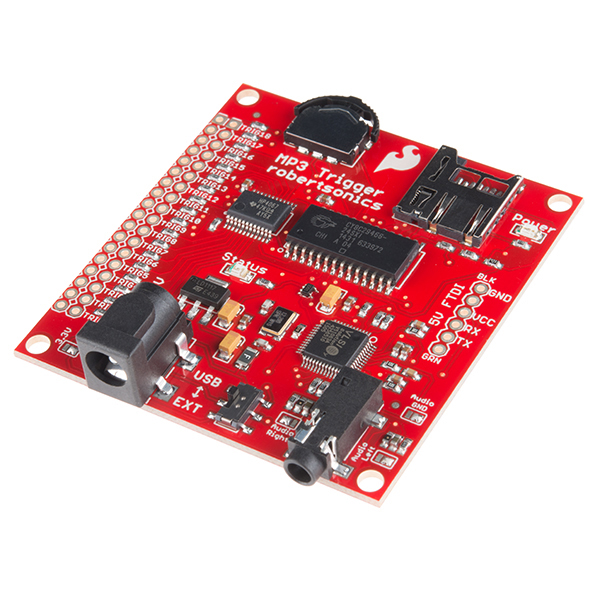 |
The updated MP3 Trigger V24 from SparkFun is now for sale. This new version features improved firmware that can read a configuration file from the SD card, making it much easier to use without a microcontroller. We posted previously about a project using an A-Star 32U4 and an MP3 Trigger to make a Scary shaking tombstone. The MP3 trigger also pairs nicely with the Maestro Servo Controllers because you can use a Maestro servo controller’s scripting capability to trigger sounds to play in sync with motion. You can see examples of how people are using them on our forum here and here.









